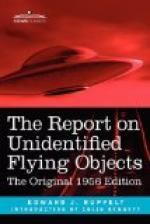Of the 1,593 reports that had been analyzed by Project Blue Book, and we had studied and evaluated every report in the Air Force files, we had been able to explain a great many. The actual breakdown was like this:
Balloons.....................18.51%
Known 1.57
Probable 4.99
Possible 11.95
18.51
Aircraft.....................11.76%
Known 0.98
Probable 7.74
Possible 3.04
11.76
Astronomical Bodies........14.20%
Known 2.79
Probable 4.01
Possible 7.40
14.20
Other ........................4.21%
Searchlights on clouds, birds, blowing paper, inversions, reflections, etc.
Hoaxes........................1.66%
Insufficient data..........22.72%
(In addition to those initially eliminated)
Unknowns.....................26.94%
By using the terms “Known,” “Probable,” and “Possible,” we were able to differentiate how positive we were of our conclusions. But even in the “Possible” cases we were, in our own minds, sure that we had identified the reported UFO.
And who made these reports? Pilots and air crews made 17.1 per cent from the air. Scientists and engineers made 5.7 per cent, airport control tower operators made an even 1.0 per cent of the reports, and 12.5 per cent of the total were radar reports. The remaining 63.7 per cent were made by military and civilian observers in general.
The reports that we were interested in were the 26.94 per cent or 429 “Unknowns,” so we had studied them in great detail. We studied the reported colors of the UFO’s, the shapes, the directions they were traveling, the times of day they were observed, and many more details, but we could find no significant pattern or trends. We did find that the most often reported shape was elliptical and that the most often reported color was white or “metallic.” About the same number of UFO’s were reported as being seen in daytime as at night, and the direction of travel equally covered the sixteen cardinal headings of the compass.
Seventy per cent of the “Unknowns” had been seen visually from the air; 12 per cent had been seen visually from the ground; 10 per cent had been picked up by ground or airborne radar; and 8 per cent were combination visual-radar sightings.
In the over-all total of 1,593 sightings women made two reports for every one made by a man, but in the “Unknowns” the men beat out women ten to one.
There were two other factors we could never resolve, the frequency of the sightings and their geographical distribution. Since the first flurry of reports in July of 1947, each July brought a definite peak in reports; then a definite secondary peak occurred just before each Christmas. We plotted these peaks in sightings against high tides, world-wide atomic tests, the positions of the moon and planets, the general cloudiness over the United States, and a dozen and one other things, but we could never say what caused more people to see UFO’s at certain times of the year.




